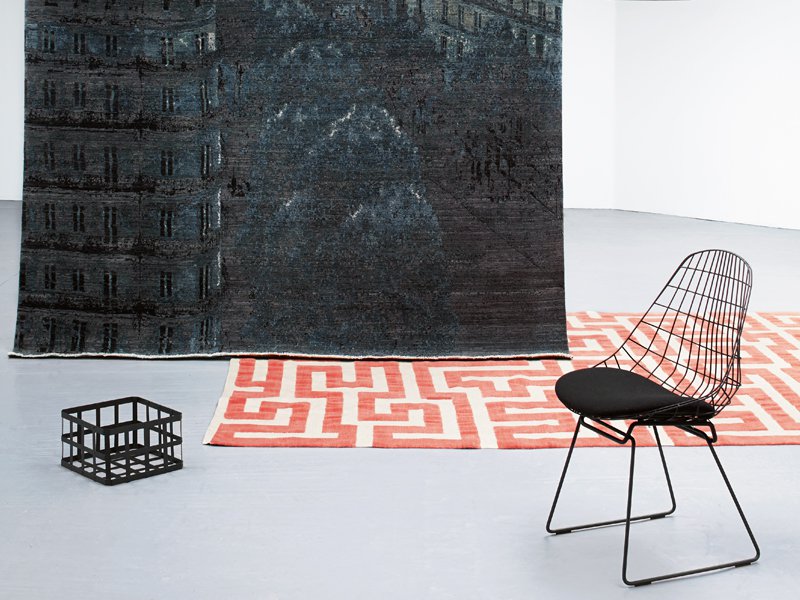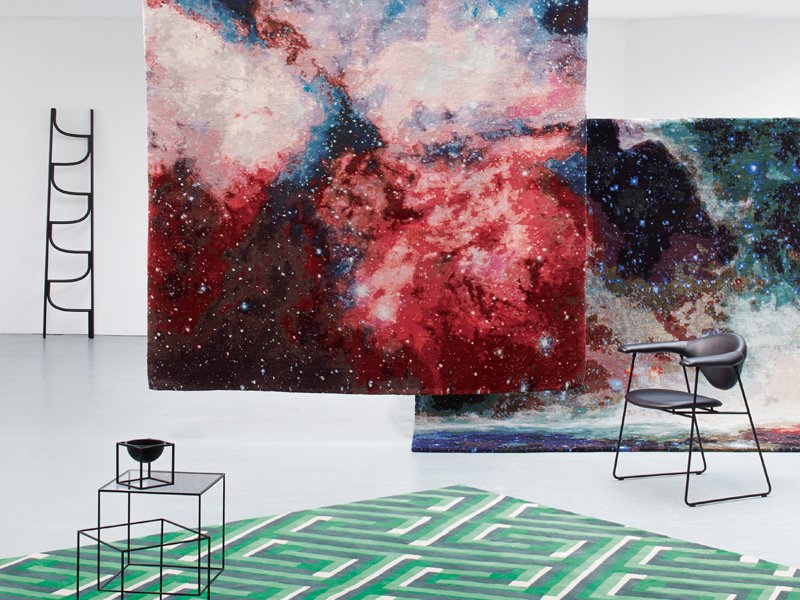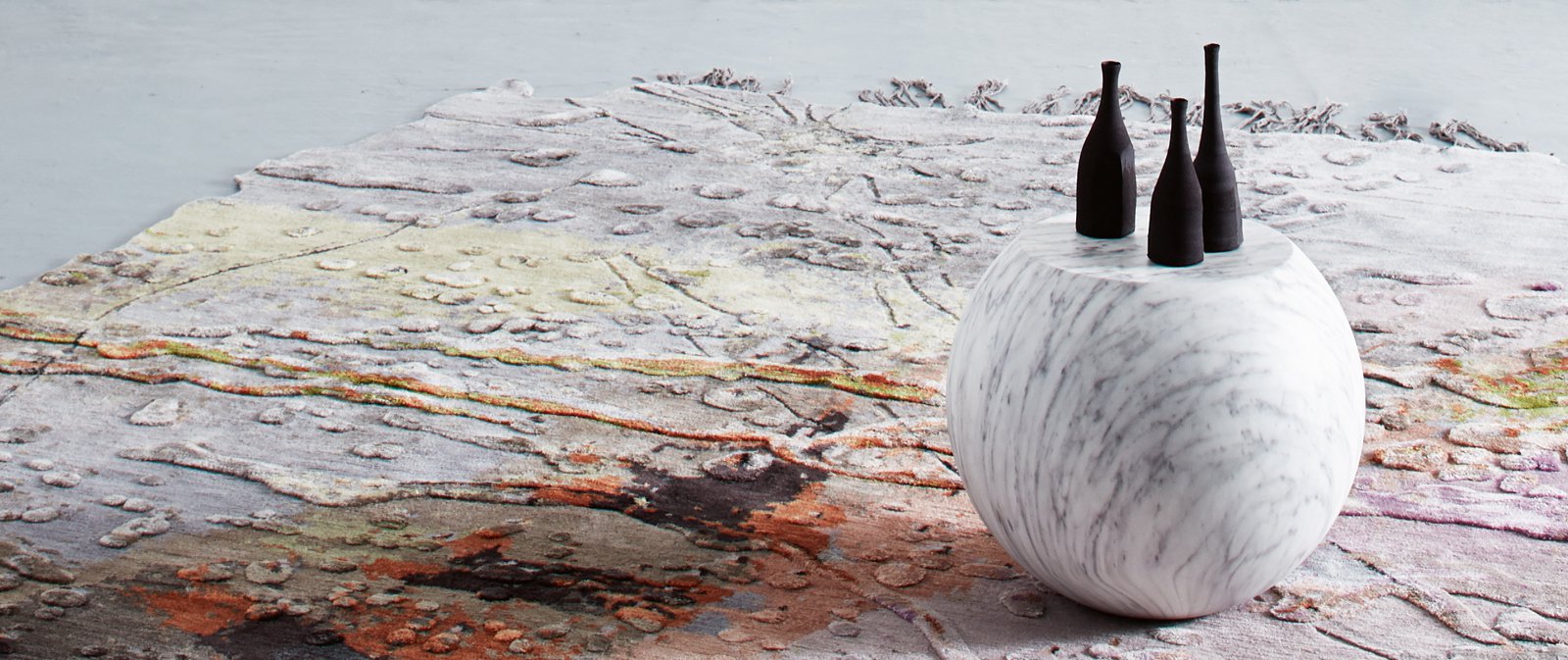The Magic of Carpets & Luxury Rugs
Traditional Persian motifs are being replaced with vistas of the cosmos and the faces of fashion designers as luxury rugs get a modern makeover
Traditional Persian motifs are being replaced with vistas of the cosmos and the faces of fashion designers as luxury rugs get a modern makeover
In 1949 prominent Russian anthropologist and archaeologist Sergei Rudenko found what is now referred to as the Pazyryk carpet in the grave of a Scythian prince in the Pazyryk Valley, in Siberia’s Altai Mountains. Radiocarbon testing indicated that the Pazyryk carpet was woven in the fifth century BC, making it the oldest surviving example of an entire rug ever discovered. Far from being primitive in construction, the Pazyryk has a highly sophisticated weave, design, and finish; it is woven in the same way as rugs being produced today. The production process of handmade carpets has, in fact, changed little in 2,500 years. There is, however, nothing antiquated about the booming contemporary rug market—a thriving industry able to keep up with every aspect of cutting-edge interior design.
James Ffrench, former head of the carpets department at Christie’s New York, now at Beauvais Carpets, explains that the past 10 years have seen a dramatic shift “from a concentration of interest in antique carpets to new-production carpets.” Matthew Bourne of Christopher Farr, which has stores in both London and Los Angeles, agrees: “These days contemporary is the most dynamic area of the entire rug market.”

A much-needed change of perspective with regard to floor coverings is being led by the people designing and creating important interiors projects. As Fabrizio Cantoni, owner of Milan-based rug company cc-tapis, observes: “For a long time, architects wouldn’t include the rugs in their projects, considering them a minor issue the client could fix alone. Luckily things have evolved, and rugs finally have the place they deserve in a project.”
“These days contemporary is the most dynamic area of the entire rug market.”
James Ffrench, Beauvais Carpets
The profile of rugs has today risen to that of an integral part of an interior scheme. Michael Mandapati, founder of New York-based luxury carpet brand Warp & Weft, whose rugs can be seen in The Ritz-Carlton Hotel in Boston and Park Hyatt hotel in Bangkok, adds that “interiors have become increasingly inventive and eclectic, calling for a wider range of styles, patterns, and colors.”
REINVENT, REWORK, REMODEL
The choice of floor coverings available is indeed better than ever. Whether you want your rug to be made of cashmere, linen, hemp, or silk, feature Swarovski crystals or LED lighting, have a traditional or contemporary design, or a mixture of both, there is a rug for every taste.
Numerous global brands set out to turn our notions of what a rug is on its head. German designer Jan Kath has reinvented the traditional rug by reworking designs like the Mamluk and Bidjar carpets with effects such as graffiti, distortion, overlaid designs, and pattern disintegration, to produce pieces that are truly show-stopping.

Artists in other media are bringing their influence to bear on this new appreciation of what rugs can do and be. Christopher Farr, who set up his eponymous store with Bourne in 1988, was one of the first figures to ask artists to design rugs; The Rug Company later brought the idea to a wider, more celebrity-savvy audience. It recently announced a new collection with red-hot fashion label Rodarte. And Swedish company Henzel Studio recently undertook the Henzel Studio Collaborations project, which saw artists from Juergen Teller and Richard Prince to Helmut Lang and Marilyn Minter designing rugs based on their artworks.

Teller’s nude portrait of Vivienne Westwood woven into a grand rug has caused a particular stir. Similarly attention grabbing was the Underworld carpet by cutting-edge Belgian design duo Studio Job for Italian brand Nodus.
TO HAVE AND HAVE KNOT
So what is the price tag of a one-off rug? Depending on the materials used (silk being the most expensive) and knot count (a standard nine-foot by 12-foot rug can have 1.5 million knots), prices for a high-end custom rug can vary from £300 to £3,000 ($480-$4,800) per square meter.
And what are clients looking for? The consensus is clear: quality, design, and the option to customize. Carol Sebert, co-founder of Toronto firm Creative Matters, regularly works with clients to develop designs used in the production of custom rugs. “It is a process that takes between six and nine months,” she says. “The computer allows us tremendous creative flexibility. We usually offer our clients numerous options along a certain theme. Working with Photoshop (our usual design tool) allows us to create different versions and we can try different colorways, motifs, scales… it’s a very creative way to work, and is great fun too.” Interestingly, while rescaling and coloring can be done digitally for speed, most rug designers still prefer to draw, etch, and do other bits of design work by hand.
From all sides there is a clear message of what constitutes a great rug. It is a matter of sourcing the finest wool, which is hand-carded, hand-spun, and then dyed using high-quality natural dyes. Judiciously chosen tools and techniques then make everything possible, as Jürgen Dahlmanns of Rug Star explains: “We try to be as authentic as possible in all parts of the production to ensure we get the best out of this art form. The design—but also special finishes of the completed rug—can help to keep it fresh and contemporary.”
Much luxury rug production now happens in Nepal, but other centers of weaving are re-emerging in areas previously known for rug creation: India, Turkey, Iran, and even Afghanistan, where companies Ariana and Amadi produce their rugs, and where the AfghanMade campaign to promote and revitalise traditional industries focused its efforts.
And with developments in design technology advancing every season, the bespoke services offered by rug makers will only get better. As Ffrench so eloquently puts it: “Some really wonderful things are being made that should ensure the continued existence of a vibrant carpet culture.” Here’s to another 2,500 years…